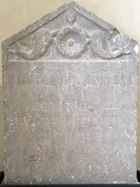Municipium of Fulginia
Documentary Evidence
Cicero
As discussed on the previous page, the earliest surviving documentary reference to Fulginia comes in Cicero’s speech ‘pro Vareno’. Unfortunately, the speech itself no longer survives, but its substance can be at least partially reconstructed from surviving testimonies and fragments. Jane Crawford (referenced below), who has collected and commented upon the surviving information (at pp. 7-18), tentatively dated the trial to the period 77-6 BC (at p. 9).
The speech was made in defence of Lucius Varenus, who was charged with the murder of two of his relatives and the attempted murder of a third. We know from Quintilian that:
-
“... in the ‘pro Vareno’, [Cicero tried to divert] the charge from the accused to the slaves of Ancharius [Rufus]” (‘Institutio Oratoria’, 7:2:10).
The mentions of Fulginia are recorded in two fragments of the speech that were commented on by Priscian, whose book on Latin grammar was written in ca. 500 AD:
-
“Cicero ‘pro Vareno’: «G(aius) Ancharius Rufus fuit e municipio Fulginate»:
-
idem in eadem: «in praefectura Fulginate»” (‘Institutiones Grammaticae:
-
de Nomine’ 2:348, 18-20, search on “Fulginate”);
which I translate as:
-
“Cicero, in ‘pro Vareno’: «G(aius) Ancharius Rufus was from the municipium of Fulginia; and, in the same work: «[something of relevance occurred] in the prefecture of Fulginia”.
The most likely scenario is probably that put forward by both:
-
✴Guy Bradley (referenced below, at p. 143):
-
“Fulginia was probably a Roman prefecture until the Social Wars, after which it became a municipium”; and
-
✴Simone Sisani (referenced below, 2007, at p. 141):
-
“...the reference by Cicero to a ‘prefectura Fulginiatum’ should be related to the status of the settlement prior to the Social Wars” (my translation).
Pliny the Elder
Pliny the Elder (‘Natural History’, 3:19), included the Fulginates in his list of the peoples of Umbria who were assigned to the Augustan Sixth Region. Thus, we can reasonably assume that Fulginia was constituted as a municipium by ca. 7 BC, the date of Augustus’ administrative reform of Italy.
Epigraphic Evidence
There is epigraphic evidence that Fulginia was administered by quattuorviri at least from the early imperial period. For example, the Museo Archeologico, Palazzo Trinci displays:
-
✴three fragments (illustrated on the right, above) of a long slab from the Villa La Quiete in Colpernaco (some 5 km east of Foligno) that recorded an unknown quattuorvir quinquenalis, [...] IIII VIR QUIN[....], a municipal magistrate responsible for the five-yearly census; and
-
✴a slab from an unspecified location , which is inscribed L(ucius) V[....] (illustrated on the left, above).
Luigi Sensi (referenced below, 1984, at pp. 478-9) recorded that the three fragments from Villa La Quiete had been re-used in an early medieval tomb there and observed that:
-
“... they were incised with letters that would have been picked out in bronze, which were usually characteristic of the paving of fora. ... This therefore confirms that [Fulginia] had a notable vitality in the early imperial period, when it was [apparently] urbanised” (my translation)
The slab inscribed L(ucius) V[....] seems to be otherwise unedited, but the manner in which it is now displayed suggests that the museum associates it with the fragments from Villa La Quiete. I wonder whether it referred to Lucius Varenus, the quattuorvir iure dicundo of CIL XI 5220a (below) or an eponymous member of his family.
Two slightly later inscriptions from Foligno or its environs mention (or mentioned) a quattuorvir iure dicundo (one of the two senior quattuorviri, who had responsibility for legal affairs):
-
✴CIL XI 5220a, a now-lost inscription that was recorded in 1618 commemorates:
-
L(ucius) Varenus L(uci) f(ilius)/ Lucullus
-
IIIIvir i(ure) d(icundo)
-
tr(ibunus) milit(um) / praef(ectus) fabr(um) quinq(uennalis) ite(rum)/ pontif(ex)
-
According to Ségolène Demougin (referenced below, at p. 326) , this inscription pre-dates the reign of the Emperor Claudius (41-54 AD).
-
✴CIL XI 5225 from San Valentino di Civitavecchia, which is now in the Museo Archeologico, Palazzo Trinci and which the museum dates to the 1st century AD) commemorates a quattuorvir iure dicundo, probably named Caius Septulmius.
Sullan Period
Ronald Syme (referenced below, at p. 276) observed that the crimes that were committed at Fulginia in ca. 80 BC, as evidenced by Cicero’s speech ‘pro Vareno’:
-
“... give more than a hint of the things that might go on in Umbria during or after the [Sullan] proscriptions.”
[More]
Triumviral Period (43 - 31 BC)
Land Confiscation in the Valle Umbra
In the aftermath of the murder of Julius Caesar in 44 BC, Octavian (Caesar’s son by posthumous adoption) agreed with his former enemies, Mark Antony and Lepidus, on the formation of a triumvirate (dictatorship of three), an allegedly temporary arrangement ahead of the expected war against the last of Caesar’s assassins (principally Cassius and Brutus). In a momentous meeting at Bononia (Bologna) in October 43 BC, as an inducement to their soldiers to continue the civil war, the triumvirs designated 18 Italian towns and cities for their settlement after the expected victory. Thus Appian recorded that, while they were still at Bononia:
-
“To encourage the army with the expectation of booty, [the triumvirs] promised [the soldiers], beside other gifts, 18 cities of Italy as colonies - cities that excelled in wealth and in the splendour of their estates and houses - which were to be divided among them (land, buildings, and all), just as though they had been captured from an enemy in war. The most renowned among these were: Capua; Rhegium; Venusia; Beneventum; Nuceria [in Campania]; Ariminum; and Vibo. Thus were the most beautiful parts of Italy marked out for the soldiers” (‘Civil Wars’, 4:3).
Cassius and Brutus were duly defeated at Philippi in 42 BC, after which, as Josiah Osgood (referenced below, at p. 159) observed:
-
“[Mark] Antony remained to settle affairs in the east, while Octavian hurried to a terrified Italy to distribute the land promised to Caesar’s veterans.”
Laurence Keppie (referenced below, at p. 63) deduced the probable identities of all 18 of the Italian towns that had been selected for veteran settlement after Philippi: crucially for our purposes, his list included Hispellum (Spello). Keppie’s deduction in this case (at p. 178) was essentially based on this autobiographical passage by the poet Propertius:
-
“Ancient Umbria gave birth to [me], at a noble hearth ... , where misty Mevania [Bevagna] wets the open plain, [where] the summer waters of the Umbrian lake steam, and [where] the wall of climbing Asisium [Assisi] towers from the summit, that wall made more famous by [my] genius. Not of an age to gather them, [I nevertheless] gathered [my] father’s bones, and [was myself] forced to find a meaner home since, though many bullocks ploughed [my] fields, the merciless measuring-rod [of the Roman land surveyors] stole [my] wealth of land” (Book IV, Elegy 1a).
From this passage, it seems that Asisium and perhaps Mevania, had suffered land confiscations, which would almost certainly been associated with the deduction of the colony at nearby Hispellum, probably in 41 BC. Keppie suggested that this slightly pre-dated the Perusine War (below) and probably led to local support for the Roman rebels who opposed Octavian.
It is possible that other cities of the Valle Umbra, including Fulginia, had land confiscated and assigned to the new colony at this time. However, as discussed below, while there is evidence that some land on the northern fringes of the city was assigned to Hispellum, it seems that these assignments occurred in the more benign climate after 27 BC, when the land in question was probably obtained by purchase.
Perusine War (41 - 40 BC)
When, in 41 BC, the consul Lucius Antonius (the brother of Mark Antony) revolted against the triumvir Octavian (the future Emperor Augustus), he (Lucius) famously and tragically soon found himself besieged at Perusia (Perugia). His ally and sister-in-law Fulvia (the wife of Mark Antony) tried to muster help for him from those of Mark Antony’s generals who remained in the west (while Mark Antony himself was in Egypt); the generals in question included: Publius Ventidius Bassus; Caius Asinius Pollio; and Lucius Munatius Plancus. Appian described the disposition of the associated armies:
-
“Fulvia urged Ventidius [and] Asinius ... to hasten from Gaul to the assistance of Lucius, and [also] collected reinforcements [from southern Italy], which she sent to Lucius under the lead of Plancus. He [i.e. Plancus] destroyed one of Octavian's legions, which was on the march to Rome. While Asinius and Ventidius were proceeding ... to the relief of Lucius ... Octavian and Agrippa, leaving a guard at Perusia, threw themselves in the way. [Asinius and Ventidius] retreated: Asinius to Ravenna; and Ventidius to Ariminum [Rimini]. Plancus took refuge in Spoletium. Octavian stationed a force in front of each, to prevent them from forming a junction, and returned to Perusia, where he speedily strengthened [the siege]” (‘Civil Wars’, 5:33).
Fulginia was soon caught up in what was, in effect, a civil war among Romans. Thus, according to Appian:
-
“Ventidius and his officers, ashamed to look on while Lucius was starving, [finally] moved to his support, intending to overpower [the besieging army]. Agrippa and Salvidienus [Octavian’s generals] went to meet them with still larger forces. Fearing lest they should be surrounded, [Ventidius and his men] diverted to the stronghold of [Fulginia], 160 stades from Perusia. There Agrippa besieged them, and they lit many fires as signals to Lucius. Ventidius and Asinius were of the opinion that they should still go forward and fight, but Plancus said that, as they were between Octavian and Agrippa, they had best await events [i.e. remain where they were]. The opinion of Plancus prevailed. [The besieged people] in Perusia rejoiced when they saw the fires [at Fulginia] but, when Ventidius delayed his coming, they conjectured that he, too, was in difficulties, and when the fires ceased they thought that he had been destroyed” (‘Civil Wars’, 5:35).
In despair of help, and after a final attempt to break the siege, Lucius surrendered and the war was at an end. Lucius and his men were allowed to withdraw, but Perusia suffered mightily for having supported him: the city was burned to the ground and its extra-urban territory was confiscated.
Location of the ‘Stronghold of Fulginia’: Santa Maria in Campis ?
An important assertion in Appian’s account is that,when Ventidius finally resolved to offer meaningful support to Lucius at Perusia, he marched from Ariminum to Fulginia. There is some doubt about the phrase that Appian used to describe described Fulginia, which can be transcribed “Foulkinion ti chorion”: the Loeb translation that I relied on above rendered it as “the stronghold of Fulgunium”, but the translation of John Carter (referenced below) gave simply “a place called Fulginium”. As I understand it, “chorion” can bear a number of translations, including both of these (as well as a number of others that relate to place).
I think that, whether or not Appian specified that Fulginia was easily defended, Ventidius must have considered it to be the safest place for his army that was in easy reach of Perusia. This was certainly the view of Luigi Sensi (referenced below, 1984, at p. 478), who inferred from this passage that:
-
“... at least in the late Republican period, when it was constituted as a municipium, [Fulginia] must have been protected by a circuit of walls. [The episode in the Perusine War described above] would lead one to conclude that [this was the case] in 40 BC” (my translation).
He pointed out that Silius Italicus, a poet living in the 2nd century AD, described:
-
“... Fulginia, which stands unwalled on the open plain” (‘Punica’, 8:460).
For Luigi Sensi, Silius Italicus:
-
“.. seems to allude to a non-concentrated urbanisation [at Fulginia, a model] moreover attested by the archeological evidence [from Santa Maria in Campis]” (my translation).
Thus, Sensi’s tentative hypothesis has Ventidius and his army confined by Octavian’s army in 40 BC at Fulginia, a city on the site of Santa Maria in Campis (shown to the right in the aerial view below), the walls of which were presumably subsequently demolished.
The problem with this hypothesis is that there is no archeological evidence that the Roman site uncovered at Santa Maria in Campis ever had walls. Luigi Sensi recorded (at pp. 467-8) the discovery here in 1811 of what seems to have been a thermal complex of the early imperial period that was apparently bounded to the west by a wall of polygonal travertine blocks that would have pre-dated it. He commented that:
-
“The lack of any other data relating to [this wall] makes it difficult to establish its function, for which one would need further information. Hypothetically, it could be part of the city wall of the Republican period, which we know to be documented for Fulginia [or at least implied by Appian’s account]” (my translation).
However, Sensi recognised the need for caution because this hypothesis was not supported by any other evidence.
Location of the ‘Stronghold of Fulginia’: Modern Foligno ?

Outline of the putative Roman city of Fulginia, from P. Camerieri (2015, p. 107, Figure 15)
superimposed on an aerial view of modern Foligno
Bridge(s) across the Topino might have existed at site P1 and/or site P2 in 40 BC
Some scholars alternatively locate Roman Fulginia at modern Foligno: for example, Paolo Camerieri (referenced below) believed that its street plan survives in that of the modern city (outlined in black on the aerial view above). Once again, we have no hard evidence for a circuit of city walls here, but there is the alternative possibility that this putative city was defended by earthworks and ditches fed from the Tinia/ Topino (as was the case for the medieval city).
Supporting evidence can perhaps be found for this hypothesis in the form of two hoards of silver coins that were discovered at Santa Maria in Campis (at sites marked ‘HH’ in the aerial view above).
-
✴156 coins survive from a hoard that was discovered here in 1962 (as described by Samuele Ranucci [a], referenced below). The oldest of these coins date to the 3rd century BC and the most recent was a denarius from the period 42-40 BC.
-
✴A second hoard of over 3,000 coins in a leather sack (described by Samuele Ranucci [b], referenced below) was discovered in tact in 1998, barely 100 meters from the first. These coins covered a similar time span.
The excavations that uncovered the second hoard also revealed that it had been buried in an area that had been in use as a cemetery at the time of the Perusine War (a good place to bury valuables). We can reasonably speculate that both hoards were buried in similar circumstances, perhaps by the same person or people. The surviving coins from both hoards are now exhibited at the Museo Archeologico, Palazzo Trinci.

RRC 523/1a: C·CAESAR·III·VIR·R·P·C/ Q·SALVIVS·IMP·COS·DESIG
The most recent coin (RRC 523/1a, illustrated above) in the second hoard had been minted by Octavian’s general, Salvidienus, in his capacity as consul-designate. Fortunately, we can date the this coin quite precisely: Salvidienus had been nominates as one of the consuls for 39 BC, but he was subsequently accused of treachery against Octavian and died (either by suicide or execution) after the Perusine War but before he could take up his office. The coins issued in his name therefore date to 40 BC. Samuele Ranucci [c] (referenced below, at p. 89) reasonably observed that:
-
“It seems probable that the coins had been minted by the besiegers of Perusia for the [payment of the] legions engaged in the war effort ...” (my translation).
Of course, the besiegers of Perusia were also the besiegers of the army of Ventidius at Fulginia at this time. Samuele Ranucci [c] (referenced below, at p. 87) suggested that the hiding of these coin hoards was probably directly related to these events.
The museum commentary indicates that, in 40 BC, the value of the coins in this hoard would have been been somewhat in excess of the amount that a single legionary would have earned during his entire career. Samuele Ranucci [b] (referenced below, at p. 26) pointed out that there is no secure basis on which to determine what the precise reasons for the hiding of this fortune might have been:
-
“One can, of course, speculate, imagining, for example, that we are dealing with the savings of a high-ranking officer or the valuable loot of a thief, rather than the treasury of an army, buried in a hurry. Alternatively, as is probably preferable, we could leave the explanation to the imagination of each individual” (my translation).
We can also only speculate on the reason why the owner of the coins never returned to recover them. We can, however, reasonably assume that these coins were buried by:
-
✴an officer in Octavian’s army; or
-
✴someone who had stolen them or obtained them by some other means from such an individual or from army coffers.
In short, we might reasonably assume that a detachment of Octavian’s army was camped nearby in 40 BC.
If so, we must look for the ‘stronghold of Fulginia’, in which Ventidius was confined by Octavian’s general, Agrippa, in a different, albeit nearby, location. It is tempting to place it on the site of modern Foligno, between the camp of Octavian’s army and the river, and to assume that Octavian destroyed any bridges across this stretch of the river as part of the blockade. However, the scant archeological evidence for a Roman stronghold here is disputed.
Evidence for Ancient City Walls at Modern Foligno?
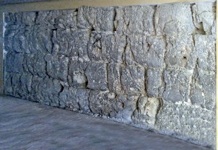
Palazzo Piermarini, 50 Via Gramsci
Unfortunately, as was the case for the proposed location at Santa Maria in Campis, there is no undisputed archeological evidence of Roman city walls on the site of modern Foligno: although a number of large blocks that were probably cut in the Roman period were re-used in buildings along Via Gramsci (i.e. along the northwestern boundary of the putative Roman city), most, if not all, of these buildings stand entirely on medieval foundations. However, there is one possible exception: the left side of what was once a tower (now part of Palazzo Piermarini) incorporate a stretch of wall made of Roman travertine blocks, some 7 meters long by about 2 meters high (visible to the right if the door at number 50 is open):
-
✴According to Giuliana Galli (referenced below, 2015, at pp. 47-50), this stretch of wall:
-
“... is built in opus quadratum in squared blocks, prepared with accurately worked contact surfaces and quite precise joints. The orientation NW-SE is compatible with the orthogonal structure of the walls of a tower on the northern limit of the [putative Roman] castrum” (my translation).
-
She dated them to the 3rd century BC, and related them to the walls of Lucca, which were probably built at the time that a Roman colony was established there in 180 BC (see Lily Ross Taylor, referenced below, for this date). She returned to this site in a later paper (referenced below, 2016, at pp. 113-4), suggesting that:
-
“There is [also] a direct correspondence with some tracts of the Roman city walls at Terni (the prefecture of Interamna Nahars) ... the surviving circuit of walls [there] is in opera quadrata of ... local travertine ... The proposed dating is around the 3rd century BC”
-
✴However, while scholars generally accept that this wall was built using Roman stones, many doubt that it stands on Roman foundations:
-
•Paola Guerrini and Francesca Latini (referenced below, pp. 314-55, in entry 101), quoted Laura Bonomi Ponzi but without a specific reference:
-
“For Bonomi Ponzi, this very small ambient suggests its use as a tower, probably in the medieval period, so it seems likely that the ancient blocks have been reutilised for its base” (my translation).
-
•Matelda Albanesi (in Guerrini and Latini, referenced below, Appendix 2, pp. 362-3) also believed that these Roman blocks had been reused in what she considered to be a medieval building.
Unfortunately, unless it proves possible in the future to conduct an intrusive excavation of the foundations of this wall, the matter is likely to remain unresolved.
My View
Even if there were conclusive proof that the tower at 50 Via Gramsci stands on Roman foundations, this would not be conclusive proof of a Roman city protected by a circuit of walls. On the other hand, the absence of such walls does not preclude this as the location of Roman Fulginia: it is possible that the putative Roman city here was protected by ditches and earthworks (as was the case for the medieval city). However, that would be difficult to prove. In short, while it is possible that Ventidius took refuge here in 40 BC, and that Agrippa established his camp at Santa Maria in Campis, the evidence is inconclusive.
Fulginia under Augustus (27 BC - 14 AD)
Political Climate after Actium
The people of the Valle Umbra had seen the worst in the young triumvir Octavian in 41-40 BC, at the time of the land confiscations that had facilitated the deduction of the colony of Hispellum and of reprisals that followed the Perusine War. However, the political climate was transformed by Octavian’s victory over Mark Antony at Actium (31 BC), after which he emerged as the undisputed ruler of the Roman Empire:
-
✴in 29 BC, Octavian celebrated a triple triumph (for his victories in Dalmatia, at Actium and in Egypt); and
-
✴shortly thereafter, as he somewhat disingenuously proclaimed in his autobiography:
-
"In my sixth and seventh consulships [28 and 27 BC], when I had extinguished the flames of civil war, after receiving by universal consent the absolute control of affairs, I transferred the Republic from my own control to the will of the Senate and the Roman people. For this service on my part, I was given the title of Augustus ... After that time I took precedence of all in rank, but of power I possessed no more than those who were my colleagues in any magistracy" (‘Res Gestae Divi Augusti’, 6: 34).
Now Octavian, whom we might reasonably dub the Emperor Augustus, was able to spend some of the substantial spoils from his victories on the commemoration of the peace, security and prosperity that alone would justify his extraordinary position of power.
Restoration of Via Flaminia (27 BC)
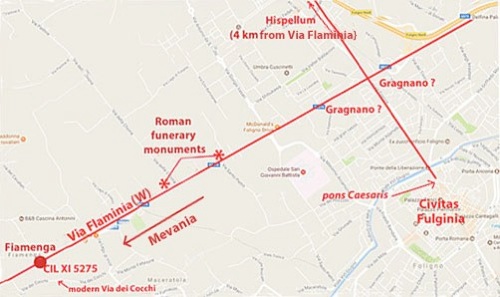
Western branch of Via Flaminia, between Hispellum and Fulginia
In his autobiography, Augustus recorded that:
-
“As consul for the seventh time [in 27 BC], I [restored] the Via Flaminia from [Rome] to Ariminum [modern Rimini, on the Adriatic coast]...”, (‘Res Gestae Divi Augusti’, 4:20).
An indication of the source of finance for this restoration comes from Suetonius, who noted that, when Augustus was restoring Via Flaminia, he also:
-
“... assigned the [restoration of the other main Roman] highways to others who had been honoured with triumphs, asking them to use their prize-money in paving them” (‘Life of Augustus’, 30).
We might therefore reasonably assume that Augustus used part of the receipts from his own triple triumph of 29 BC to finance his restoration of Via Flaminia. There is also surviving evidence for the political significance of the project: according to Cassius Dio:
-
“[Via Flaminia] was finished promptly ... and statues of Augustus were accordingly erected on arches on [the Milvian Bridge, outside Rome] and at Ariminum”, (‘Roman History’, 53:22).
Carsten Hjort Lange (referenced below, at pp. 161-2 and note 46) cited coins that suggest that these were:
-
“ ... ‘triumphal arches’, in as much as they were connected to triumphs, even if their [stated] purpose was to honour Augustus for road building. ... [They] operated as triumphal markers in Rome and Italy, glorifying the victory at Actium.”
Frances Hickson (referenced below, at p. 134) made a similar point:
-
“Both the repair [of Via Flaminia] and [erection of] the arches [at its ends] were part of a Republican tradition by which many triumphatores built or restored public buildings and works in fulfilment of vows and as a means of memorialising their victories.”
This project certainly included the construction of the famous Ponte di Augusto at Narnia (modern Narni), at the start of the western branch of the road: almost 600 years later, Procopius recorded that:
-
“This bridge [at Narnia] was built by Caesar Augustus in early times, and is a very noteworthy sight; for its arches are the highest of any known to us” (‘History of the Wars’, 5:17).
This was the start of the branch that ran through Mevania and then between Hispellum and Fulginia before meeting up with the other branch (through Spoletium) at Forum Flaminii. It is possible that this restoration privileged the western over the eastern branch of the road: as noted on the previous page, Strabo’s account of Via Flaminia, which was written about two decades later and which is the earliest such account to survive, has Mevania on the road and Spoletium “to the right of [it]” as one travelled away from Rome.
I argue below that this restoration of the western branch of Via Flaminia should be considered together with:
-
✴a second wave of settlement at Hispellum that involved veterans of Octavian’s victorious army;
-
✴the impressive circuit of walls that was now built round the extended colony; and
-
✴the construction of the magnificent pan-municipal sanctuary in the plain below below these walls;
as connected parts of a major commemorative project that was designed to ensure that the victory at Actium, which had finally ended the horrors of civil war, would never be forgotten.
Second Wave of Colonisation at Hispellum ?
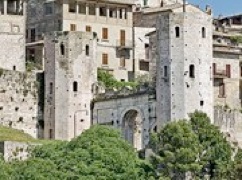
Porta Venere and the walls of Hispellum (ca. 27 BC)
Simone Sisani (referenced below, 2012, at pp. 435-6) suggested that there was a body of evidence for the hypothesis that:
-
“... the triumviral colony at Hispellum was [in effect] re-founded in the early Augustan age, probably as part of a [wider] programme of colonial reinforcement to accommodate the mass of disarmed veterans following the Battle of Actium and the victorious end of the conflict [between Octavian and Mark Antony]” (my translation).
One of the most important pieces of evidence for this is represented by the city walls of Hispellum.
Paul Fontaine (referenced below, at p. 257-9) established that:
-
✴Porta Consolare, on the decumanus maximus of Hispellum, had probably been built in ca. 40 BC as a formal entrance to the originally unwalled urban centre of the new colony; while
-
✴the walls of this urban centre (of which substantial stretches survive) apparently belonged to a later phase of construction.
He suggested that:
-
“An attractive hypothesis is that this second phase was executed at the time of Augustus’ restoration of Via Flaminia in 27 BC” (my translation).
Linda Baiolini (referenced below, at p. 90), who accepted Fontaine’s dating of the walls, observed that it was supported by the fact that Porta Venere, the most impressive gate in this circuit:
-
“... is indisputably related, not only to the Porta Palatina at Turin (28 BC), but also to the new typology of gates flanked by towers in a series of monuments in the Cisalpina that are generally (albeit not unanimously) dated to the early Augustan period” (my translation).
Paul Fontaine (referenced below, at p. 260-1) observed that the function of these new walls seems to have been to underline the importance of the colony: they certainly were not needed for defence! He pointed out that they:
-
“... have the appearance of a prestige project with an essentially symbolic meaning ... [so that they effectively] symbolised the colony [itself]” (my translation).
Thus the walls were meant to demonstrate the high status of the colony at that time, quite possibly because it now accommodated some of the heroes of Actium.
Paul Fontaine (referenced below, at p. 260-1) observed that, since inscriptions at Fano and Nîmes:
-
“... attest to the fact that their walls were built by Augustus [himself], we might ask ourselves whether the walls of Spello were not [also] a manifestation of imperial euergetism. Their refined construction presupposes the expenditure of considerable financial resources, and Augustus’ gift to the [colony] of the sanctuary of Clitumnus is indicative of his special solicitude towards it” (my translation).
This does not, of course, provide hard evidence of imperial involvement in the construction of the walls. However, it seems to me that Fontaine is probably correct and that, like the restoration of Via Flaminia, the building of these walls was probably financed from the spoils of war in celebration of his triumph.
Second Wave of Land Acquisition in the Valle Umbra ?
This putative second wave of veteran settlement at Hispellum surely required a second wave of land assignations to support the expanding colony. There is, in fact, epigraphic evidence that at least two such assignations were made in the region at this time to men from the Lemonia tribe of Hispellum:
-
✴a funerary inscription ((CIL XI 5275) that was found quite close to Fulginia (discussed below) commemorates Cnaeus Decimus Bibulus, an evocatus (a soldier who had served out his time and obtained a discharge but had voluntarily enlisted again) from legio XIII; and
-
✴a second funerary inscription (CIL XI 1933) from località Agliano, south of Perugia, which is now in the deposit of the Museo Archeologico Nazionale, Perugia, commemorates Caius Allius, a centurion of this legion.
Lawrence Keppie (referenced below, at p. 179) recorded that, while legio XIII had fought with Julius Caesar in Gaul, it had been disbanded before Philippi. However, it had been re-established by 36 BC, when (according to Appian, ‘Civil Wars’, 5:87) it had saved Octavian’s life after a disastrous battle in his war against Sextus Pompeius. According to Keppie, men serving in the re-formed legion would not have been discharged before Actium.
-
✴Lawrence Keppie (referenced below, at p. 179) suggested that:
-
“Allius and Bibulus could [both] be Caesarian evocati [re-recruited before Philippi] (although their legion was not apparently re-formed under that numeral), but the evidence is too slight to form any conclusion”.
-
If this was the case, they could have been settled at Hispellum at the time of its original deduction.
-
✴However, Simone Sisani (referenced below, 2012, at p. 436) suggested that the more likely scenario was that both men had fought in the re-formed legio XIII and were part of the putative second wave of veteran settlement at Hispellum after Actium.
In my view, Sisani is surely correct: after all, there is nothing to suggest that Allius was an evocatus.
In order to assess the circumstances in which these putative assignations were probably made, we might usefully investigate the case of the Colonia Julia Fida Tuder (at modern Todi, in southern Umbria), which had probably been established a few years before. Laurence Keppie (referenced below, at p. 71) observed that it had:
-
“ ... received veterans of legio XXXXI at an unspecified date: on Dio’s testimony, its founder members could well have qualified for release after [Octavian’s naval victory over Sextus Pompeius at Naulochus in 36 BC]. One centurion of the legion had served a centurio classicus [who would have commanded the men from the legion who were trained for naval warfare], perhaps at that battle.”
If so, then the establishment of this second colony in Umbria is unlikely to have involved a significant element of land confiscation. As Josiah Osgood (referenced below, at pp. 323-4) observed, Octavian’s self-projection following Naulochus represented:
-
“... the most significant of several shifts in [his] public image during the triumvirate. ... Now, he would try to ... [repair his image among] the segment of [Italian] society that [he] had antagonised terribly with land confiscations and dissatisfied still further with the war against Sextus [Pompeius]... [He now wanted] to show that there would be an end to chaos, that ... property rights did matter. ... This time, ... there was no need for dispossessed landowners [in Italy] to take up arms.”
Enrico Zuddas (referenced below, in publication) pointed to the epigraphic evidence that illustrates the pattern of settlement associated with the deduction of the new colony at Tuder:
-
“A new colony needed fertile and cultivated land; since the land around the present town of Todi is predominantly hilly and suitable for only forestry or the grazing of animals, agricultural land that could be allocated to veterans had to come from elsewhere in the Tiber valley. Consequently, it is legitimate to assume that the colony had also been assigned land in the southern and eastern part of Lake Trasimeno, which legally belonged to Perusia and Chiusi” (my translation).
In fact, as mentioned above, almost all of the extra-urban territory of Perusia had been confiscated after the Perusine War: there is no evidence of a revival of the fortunes of Perusia until the turn of the century, so this confiscated land might well have remained at Octavian’s disposal in 36 BC. Thus, we might reasonably assume that this was the source of much of the land assigned to the veterans settled at Tuder, and that few, if any, further land confiscations were required.
By the time of the putative second wave of veteran settlement at Hispellum (after Actium), the political climate was even more benign and, importantly, funds were now available on an unprecedented scale. Thus, in his autobiography, Augustus recalled that:
-
“To the municipal towns, I paid money for the lands that I assigned to soldiers in my own 4th consulship [in 30 BC] and also, thereafter, in the consulship of Marcus Crassus and Gnaeus Lentulus, the augur [in 14 BC]. The sum that I paid for estates in Italy was about 600,000,000 sesterces, and the amount that I paid for lands in the provinces was about 260,000,000. I was the first and only one to do this of all those who up to my time had settled colonies of soldiers in Italy or in the provinces” (‘Res Gestae Divi Augusti’, 3:16).
Laurence Keppie (referenced below, at p. 76) suggested that:
-
✴most of the 600,000,000 sesterces that Augustus spent on land in Italy would have related to veteran settlement in 30 BC; while
-
✴the smaller sum that he paid for land in the provinces would have related to settlement there in 14 BC.
As set out in my page of Spello: Colonia Julia Hispellum, there is evidence for a number of non-contiguous enclaves belonging to Hispellum, established over a swathe of land in the Valle Umbra and further north, towards the Tiber Valley (as was also the case for Tuder). I would like to suggest that all these non-contigiuous assignations can reasonably be associated with the putative expansion of the colony after Actium:
-
✴the land acquired for this purpose in the Valle Umbria (including that assigned to Cnaeus Decimus Bibulus) was probably purchased; while
-
✴the land in the Tiber Valley (including that assigned to Caius Allius) might have been purchased or alternatively taken from a ;’land bank’ that was still at Octavian’s disposal following the confiscations tat Perusia.
Second Wave of Land Acquisition affecting Fulginia ?
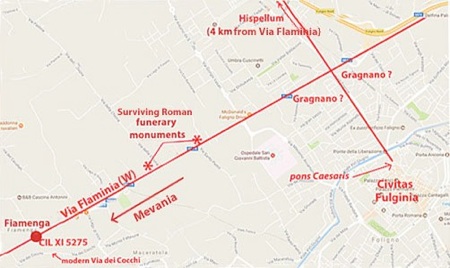
Western branch of Via Flaminia, between Mevania, Hispellum and Fulginia:
CIL XI 5275 = find spot of the epitaph of Cnaeus Decimus Bibulus
Gragnano ? = possible alternative locations of Gragnano, documented outside civitas Fulginia in 1103
Cnaeus Decimus Bibulus
that was discussed above was found:
-
“... in 1836 , in a field belonging to signor Nocchi [Cocchi ?] in vocabolo Cocchi, near the Villa di Fiamenga [marked at the lower left in the map above]” (my translation from CIL);
It reads:
Cn(aeus) Decimius Cn(aei) f(ilius) Lem(onia) Bibulus
evocatus leg(ionis) XIII / VIvir
As discussed above, Bibulus, an evocatus of Legio XIII, had almost certainly been settled at Hispellum after Actium. The inscription (which is now in the Museo Archeologico, Palazzo Trinci) records that he had subsequently served as a Sevir (member of a magustracy of six men), presumably at Hispellum.
Enrico Zuddas and Maria Carla Spadoni (referenced below, at p. 62), following Ferdinando Castagnoli, suggested that Fiamenga was at:
-
“... the point of convergence between the territories of Spello, Bevagna and Foligno” (my translation).
Thus it is not clear whether the land on which Bibulus had been buried had previously belonged to Mevania or to Fulginia. However, they pointed out that a later inscription (CIL XI 5033) from Fiamenga commemorated a magistrate from Mevania, which suggests that this city is the more likely candidate.
Gragnano
The place name Gragnano, which was used for an area on the northwestern fringes of Foligno (civitas Fulginia) in the 12th century, was probably derived from that of the gens Grania, a family that was prominent at Hispellum from an early date after colonisation: Marcus Granius was one of the duoviri who had commissioned a statue of Venus for the new extra-urban sanctuary there (discussed below), as evidenced by a now-lost inscription (CIL XI 5264). According to Paolo Braconi (referenced below, at p. 41, following Manconi et al., referenced below, p. 406, note 102):
-
“The presence of the Granii in Spello left evident traces in [a number of] local place names: [for example,] a ‘land holding at Gragnano’ was recorded in [1103] near Foligno (ancient Fulginia). In areas subject to colonial assignments, it may be assumed that the rural toponyms ... retained the names of the first holders of [assigned] land. We can reasonably conclude from this that ... it was a Granius who received the land holding [near Fulginia] that took his name. It seems unlikely that he was a stranger to the Marcus Granius who occupied the office of duovir quinquennalis [at Hispellum]: indeed, it is very likely that he was the same person or, if not, then at least a member of his family” (my translation).
Braconi, following Manconi et al., dated this document to 1183: however, it is reproduced by Paola Guerrini and Francesca Latini (referenced below, at pp. 178-9) under the year 1103, which I assume is the correct date. It recorded that a parcel of land “in comitatu Fuliensi”at a place known as ‘Gragnano’ had been donated in that year to the Abbazia di Sassovivo: according to my translation, it was bounded by:
-
✴the side road that led from Via Flaminia via the pons Caesaris to civitas Fulginia;
-
✴a second road that led “ad wadum Bornaclum”;
-
✴a third road that led from this now-unknown location back to Via Flaminia; and
-
✴by Via Flaminia itself.
This land was clearly on the south side of Via Flaminia, bounded on one side by the road that led from Via Flaminia to Fulginia. However, we cannot now determine whether the boundary that was parallel to the latter road was to the southwest or to the northeast of it (as indicated on the map above).
It is interesting to note that Paolo Braconi (referenced below, at pp. 41- 2) also referred to:
-
✴two localities in what would have been the ager Tiferinus (in the Tiber Valley, around modern Città di Castello) that seemed to indicate land originally assigned to the gens Grania:
-
•an extra- urban church, Ecclesia S. Marie de Graniano, which was documented in 1349 (see his note 24); and
-
•a locality near Sansepolcro that is still called Gragnano (see his note 25 and Figure 3); and
-
✴a funerary inscription (CIL XI 1937) from a location north of Perugia that dated to the 2nd century AD, which commemorated Versenus Granianus of the Lemonia tribe, a duovir of Hispellum and a patron of Arna, who was presumably a descendant of Marcus Granius.
As set out in its English abstract, his paper:
-
“ ... puts forward the hypothesis that the Granii estate in the higher Tiber valley was [also] founded by Marcus Granius, quinquennial duumvir of the triumviral colony of Hispellum. Indeed, we suggest that [he] was an ancestor of Marcus Granius Marcellus, proconsul in Bithynia, whom terracotta seals show as the owner of the San Giustino villa, later part of Pliny the Younger's properties ‘in Tucsis’. ”
Thus, it seems that Marcus Granius was able to use his early prominence at Colonia Hispellum to the benefit of his (probably extended) family, which acquired an impressive portfolio of land in the Valle Umbra and the Tiber Valley that is probably only partially known to us through accidents of survival.
Second Wave of Land Acquisition affecting Fulginia: My Conclusions
The evidence above suggests that at least two parcels of land on the western branch of Via Flaminia, near Fulginia (both marked on the map above), belonged to the colony of Hispellum:
-
✴land at Fiamenga, the find spot of the epitaph of Cnaeus Decimius Bibulus (CIL XI 5275), although this land might have belonged to Mevania; and
-
✴the parcel of land documented in 1103 as being in a locality known as Gragnano, to the northwest of the city, which had probably been assigned to Marcus Granius or members of his family.
It seems to me that it is at least possible that these were within a corridor of land assigned to Hispellum along this branch of the Via Flaminia. This might well explain why, in the so-called Rescript of Constantine (CIL XI 5265, ca. 335 AD), the Emperor Constantine referred to:
-
“... your city, which is now called Hispellum and which you report borders immediately on Via Flaminia ... ” (from the translation by Noel Lenski, referenced below, at pp. 118-9).
In my view, this putative development is likely to have been associated in some way with Augustus’ restoration of this branch of Via Flaminia in 27 BC, and thus with the putative expansion of the colony after Actium:
-
✴As noted above, it seems likely that Bibulus received his land at Hispellum at this time.
-
✴I would like to suggest that the land at Gragnano that was apparently assigned to Marcus Granius, together with the other apparent assignations to him near Perusia and in the ager Tiferinus, also probably took place at this time.
It seems to me that the land assigned on the western branch of Via Flaminia was probably acquired by purchase, albeit that some or all of the land assigned to the gens Granii in the Tiber valley might have involved land that had been confiscated from Perusia in 40 BC.
Pan-Municipal Sanctuary at Villa Fidelia

Aerial view of the site of the pan-municipal sanctuary below the wall of Hispellum
The likely plan of the now-demolished theatre is overlaid at the lower left
An important Hellenistic sanctuary was built below Hispellum (on the present site of the Villa Fidelia) at the time that Hispellum itself also received its new walls. It comprised :
-
✴a system of three terraces, the walls of which reflected the building techniques used in the new walls of Hispellum;
-
✴two main temples, one at each end of this middle terrace:
-
•one temple almost certainly stood at the west end of the terrace, on the site of the present Villa Fidelia (although its existence is largely inferred from the symmetrical arrangement of the site); and
-
•the second temple (securely identified during excavations stood at the east end, on a site that now belongs to the nunnery of the Suore Francescane Piccolo San Damiano; and
-
✴a remarkably large theatre that was symmetrically located in relation to these two main temples, as illustrated above.
A now-lost inscription (CIL XI 5264) from the second temple records statue of Venus that had been commissioned soon after colonisation by two duoviri, one of whom was Marcus Granius, discussed above. (A thermal complex near the site of the present church of San Claudio and an amphitheatre, slightly further to the east appear to have been built a few decades later).
This was the find spot of the inscription that recorded the so-called Rescript of Constantine (CIL XI 5265, ca. 335 AD), which indicates that the sanctuary was used by the “Umbrians” at that time. Furthermore, its unusually large theatre indicates that it had almost certainly had this pan-municipal character since the time of its construction. It seems to me that:
-
✴since one of the two main temples of the sanctuary was dedicated to Venus, the putative ancestress of the Julii Caesares, the sanctuary itself was probably devoted to the nascent imperial cult; and
-
✴since it had almost certainly been built with the fruits of Augustus‘ recent triumphs, it would have been used (inter alia) for the celebrations of festivals that celebrated the hard-won peace and prosperity of the new Augustan age.
We might reasonably assume that the people of nearby Fulginia would have participated in the celebration of festivals here.
Bridges of Foligno under Augustus
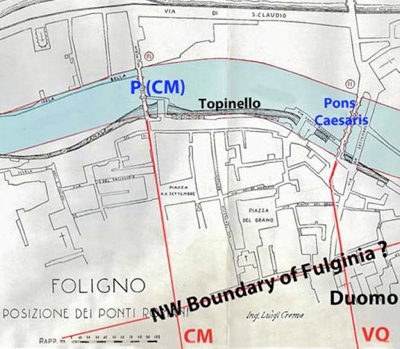
Original course of the Topino in modern Foligno and its two inner bridges (after Luigi Crema)
Northwestern boundary of putative Roman city (after Camerieri and Galli, 2016)
CM= Cardo Maximus ; VQ=Via Quintana
In 1930, the engineer Luigi Crema:
-
✴made drawings of the four bridges on what is now a canal (the Topinello or Canale dei Molini) in modern Foligno; and
-
✴used their exact locations, orientations and dimensions to establish the original course of Tinia/ Topino (i.e. before its diversion to the northwest).
He concluded from his study of the individual bridges as they then existed that all four of them dated to the late Roman period.
This conclusion has been hotly debated ever since:
-
✴some scholars (generally those who locate Roman Fulginia at Foligno) argue for an earlier date; while
-
✴others (generally those who locate Roman Fulginia at Santa Maria in Campis) argue that, with the possible exception of P3, they are medieval bridges.
This lack of consensus clearly demonstrates that it is not possible to arrive at a universally accepted view on the origins of these bridges solely on the basis of a physical examination of the surviving structures. We therefore need to look at other circumstantial evidence, including the way that they relate to the surrounding topography:
In the previous page, I argued that the outermost bridges (Crema’s P1 and P4) have no obvious topographical relationship to either the putative Roman city or what we know of the local Roman road network and are probably medieval in origin. However, the bridge that I have marked P(CM) in the plan above, which was Crema’s P2, was located at the site of a ford in the Tinia that, from 241 BC, had linked Perusia, Asisium and Hispellum to the north with Spoletium to the south: a bridge here had probably replaced the ford here at the time of the formation of the colony of Spoletium in 241 BC, and certainly by the time of the construction of Via Flaminia in 220 BC.
It is now time to look in detail at the final suggestion I made in this context on the previous page: that the medieval pons Caesaris (Crema’s bridge P3), was (as its medieval name suggests) of Augustan origin.
Pons Caesaris
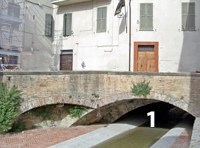
Visible arch of P3 in Via Feliciano Scarpellini

Reconstruction of bridge P3 by Luigi Crema (from G. Dominici, referenced below, p. 31)
The photograph above shows the arch of the surviving bridge P3 that is nearest to the city: the remains of another six arches survive to the right, under houses in Via Feliciano Scarpellini. At 75 meters in length, P3 was the longest of Crema’s four bridges.
Most scholars assume that this bridge was the pons Caesaris that was documented in the legend of St Felician (BHL 2846, search on ‘2846’ in this link), which was probably written in the late 840s. This recorded that St Felician, the first bishop of Forum Flaminii, died a short distance from civitas Fulginia in 250 AD and was buried:
-
“... in agello ipsius ubi ipse iusserat, iuxta Fulgineam civitatem, super pontem Caesaris”.
Thus, this ‘agellus’ (small field), in which St Felician was buried, was located near civitas Fulginia, super (above/near/ beyond) a bridge known as the pons Caesaris (bridge of Caesar).
As noted above, scholars are divided on the origins of all four bridges. In the case of the pons Caesaris, there are broadly three streams of opinion:
-
✴The present consensus is probably that articulated by Paola Guerrini and Francesca Latini (referenced below, at pp. 312-3, entry 98):
-
“This is the only one of the four bridges [across the Topino in its original course] that can probably be dated to Roman times, albeit that it survives only in its medieval form” (my translation).
-
This view of the Roman origins of the bridge is probably predicated on the reasonable assumption that it had clearly been assumed to be a Roman bridge at the time of writing of BHL 2846 (above).
-
✴More recently, Giuliana Galli (referenced below, 2015, at p. 64), argued for the Roman origins of all four bridges. In the case of this one, she concluded that:
-
“The vaults of this bridge are realised in opera cementizia covered with pink limestone blocks, with blocks of local travertine [on the upper arch] ... on the basis of construction techniques, the date could fall between the 3rd and 2nd centuries BC, albeit that this awaits confirmation on the basis of surveys of the foundations of the pylons” (my translation).
-
In a later paper (referenced below, 2016, at p. 116, note 295), she amended the dating of this bridge (and the bridge P(CM)) to the early 1st century BC.
-
✴At the other extreme, Matelda Albanesi (in Guerrini and Latini, referenced below, Appendix II, p. 357) insisted that all four bridges had been built, ab initio, in the medieval period, albeit that this one has been:
-
“... erroneously held to be Roman on the basis of [the inscription recorded by Fabio Pontano (discussed below)]” (my translation).
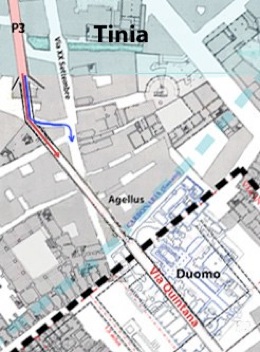
P3 (authors’ Ponte Pietra) and putative Roman city
adapted from Paolo Camerieri and Giuliana Galli (referenced below, 2016, Fig. 3)
The topographical relationship between bridge P3 and the street plan of the putative Roman city at Foligno is less obvious than it is in the case of bridge P2 (which was clearly on its cardo maximus:
-
✴There is documentary evidence from the medieval period for a road from Via Flaminia that crossed P3 (then known as the the pons Cesaris) and passed the agellus (grave) of St Felician (which was outside the medieval city but close to the Duomo) before entering the city itself (following the blue route in the plan on the right, above).
-
✴According to Paolo Camerieri and Giuliana Galli, the building of the medieval Duomo would have disrupted the original street plan (as indicated in the diagram above): in the prior period, the road across P3 would have continued along the Via Quintana of the putative Roman castrum (along the red route in the plan).
Augustan Origins of Bridge P3 ?
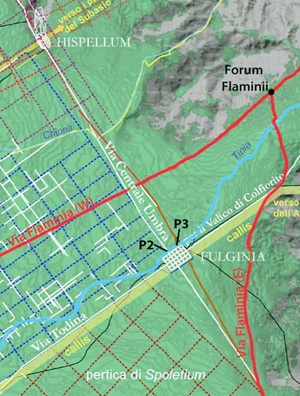
Putative castrum at Foligno (detail),
adapted from Paolo Camerieri (referenced below, 2015, p. 106, Fig. 14)
The detail above of Paolo Camerieri’s plan shows the putative Roman castrum of Fulginia, which he located at Foligno, in relation to:
-
✴bridges P2 and P3 on the Tinia
-
✴the centuriated area to the west; and
-
✴Hispellum, at the most northerly point
illustrates a perplexing fact: the roads across P2 and P3 both apparently both linked Hispellum to the eastern branch of Via Flaminia:
-
✴As noted above, there was probably a bridge at location P2 from at least 220 BC.
-
✴We might therefore reasonably ask why and when P3 bridge was built at a wider point in the river in order to provide a second link from Hispellum to the eastern branch of this road.
As noted above, Hispellum was probably a relatively unimportant centre (and perhaps belonged to Mevania) until it was colonised by Octavian in ca. 40 BC. However, its enhanced status came to the fore in ca. 27 BC, when it received its impressive walls, together with the pan-municipal sanctuary in the plain below them. It seems to me that we might well place the construction of bridge P3 within this political context, in which case its medieval name would indicate its link to Augustus, who had taken this name after his posthumous adoption by the now-deified Julius Caesar. More specifically, I wonder whether this bridge was built for a new processional road that led to this pan-municipal sanctuary.
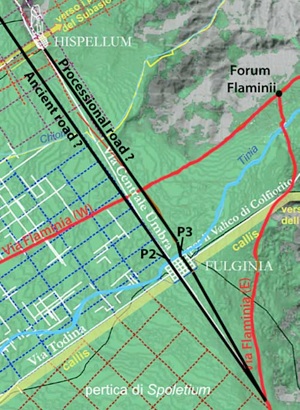
Putative castrum at Foligno (detail),
adapted from Paolo Camerieri (referenced below, 2015, p. 106, Fig. 14), as above
-
I have added two black lines:
-
•a road following the line of the putative cardo maximus from P2 towards Hispellum; and
-
•a line running parallel to it, from the northern end of P3 to Porta Consolare, Hispellum.
I have explored this possibility by superimposing two black lines on the plan above:
-
✴a line that extends the cardo maxumus of the putative Roman castrum towards Spello, which I suggest was roughly the line taken by the ancient road towards Perusia; and
-
✴the line of a putative processional route from P3 to Hispellum, ending at Porta Consolare.
Of course, this exercise does not prove very much, except that my hypothesis is at least topographically coherent.
Circumstantial Evidence from the Via Triumphalis from Mevania to Hispellum
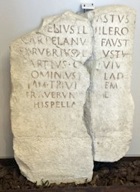
-
✴Simone Sisani (referenced below, 2012, at p. 416) dated it on paleographic grounds to the “primissima età imperiale” (i.e. to ca. 27 BC); while
-
✴the EAGLE database (see the CIL link above) suggests the first three decades of the 1st century AD (although this could reflect the date of the paving of a previously unpaved Augustan road).
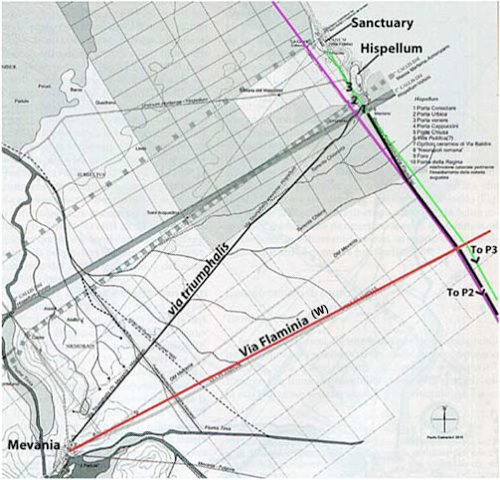
Via Triumphalis, from Paolo Camerieri and Dorica Manconi (referenced below, figure 16)
-
The original figure showed a single road (shown in black, at the right) from the west branch of Via Flaminia to the Porta Consolare of Hispellum, which the authors labelled ‘Perusia-Fulginium (Via Flaminia)’
-
I have superimposed two lines on this figure:
-
•the purple line is my suggested ancient road (from bridge P2), which Camerieri and Manconi have diverting to Porta Consolare; and
-
•the green line is my proposed processional route from bridge P3 to Porta Consolare.
Paolo Camerieri and Dorica Manconi (referenced below, at p. 77 and figures 16 and 17) deduced the likely route of the via triumphalis of CIL XI 5041, as shown in their figure 16 above. They noted (at p. 77) that this road, which originally ran in a straight line towards the Augustan Porta Urbica (marked 2 on the plan) and on to the forum of Hispellum, was diverted to the right at the edge of the Augustan centuriation of Hispellum and continued instead to Porta Consolare (1). This diversion seems to have taken place in the Augustan period, presumably at the time that the city received its new walls and the road acquired its new ceremonial status.
In the original figure, Camerieri and Manconi assumed a similar diversion of the road from P2 on the Tinia towards Porta Consolare. As noted in the caption below this figure above, I have superimposed two lines on it:
-
✴the purple line marked “to P2” assumes no diversion to Porta Consolare); and
-
✴the green line marked “to P3” is my proposed processional route from bridge P3.
Thus, on my model, two processional routes linked the western and eastern branches respectively of Via Flaminia to Porta Consolare:
-
✴the first started at Mevania; and
-
✴the second started at bridge P3.
From there, they would have passed through Hispellum to Porta Venere (3) and probably on to the pan-municipal sanctuary: as Isobel Pinder, (referenced below, at p.285) pointed out:
-
“The aspect of Porta Venere and [that] the sanctuary are exactly aligned ... and the road that linked them almost certainly formed a sacred way for processions from the city to the sanctuary ...”
Indeed, as Paolo Camerieri (referenced below, 2007, at p. 155) asserted:
-
“... it was only possible to reach the [pan-municipal sanctuary] by means of an itinerary that (at least in the post-Augustan era) led to the forum [of Hispellum] and then left [the city] by Porta Venere, which continued to the temple of Venus [in this sanctuary], as its name suggests” (my translation).
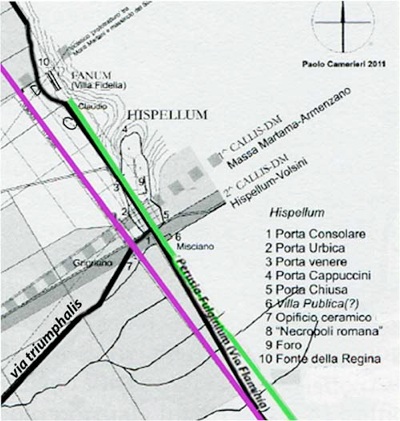
Via Triumphalis, from Paolo Camerieri and Dorica Manconi (referenced below, figure 16) - detail
-
The original figure showed a single road from the west branch of Via Flaminia (at the right) to the Porta Consolare of Hispellum, which the authors labelled ‘Perusia-Fulginium (Via Flaminia)’
-
I have superimposed two lines on this figure:
-
•the purple line is my suggested ancient road (from bridge P2), which Camerieri and Manconi have diverting to Porta Consolare; and
-
•the green line is my proposed processional route from bridge P3 to Porta Consolare.
This detail of the plan above illustrates an argument in favour of my hypothesis:
-
✴In the original plan, a single road from P2 (marked by the authors “Perusia-Fulginium (Via Flaminia), which served both normal and processional purposes, left Hispellum by Porta Venere (3) and then curved through the sanctuary, with the theatre and amphitheatre on the left and the temple terrace on the right.
-
✴On my hypothesis, the ‘purple’ road from P2 bypassed both Hispellum and the sanctuary en route for Perusia, while the road from Porta Venere to the sanctuary would have would have been reserved for ceremonial purposes.
Circumstantial Evidence from the Discourse of Fabio Pontano
The “Discourse’ (1618) of Fabio Pontano, which has recently been edited by Luigi Sensi (referenced below, 2008), includes two references to the “Ponte di Cesare’ and the inscription mentioned by Matelda Albanesi (above):
-
✴“In the place in Foligno called Ponte di Pietra [the later name for the Ponte di Cesare], there was a stone with an ancient inscription, which recorded that the bridge had been built when Lucius Antonius, the brother of Mark Antony, had passed with his army, which had come from Rome on the orders of Ottaviano Augusto Imperatore to besiege Perusia [in 41 BC], and this bridge was built across a stretch of marshy ground. Not long ago, this stone was removed and ... is no longer to be found ...” (my translation of a passage at p. 44).
-
✴“This ... bridge in Foligno, [now] called Pietra ... was originally called Ponte di Cesare, because it was built when the army of Ottaviano Augusto, the second Caesar, under the leadership of Lucius Antonius, passed here en route to besiege Perusia [in 41 BC]” (my translation of a passage at p. 53).
It is clear that either the inscription itself or the transcription of it on which Pontano relied was inaccurate: Octavian could not have ordered the army of Lucius Antonius to build this bridge at the start of the siege of Perusia, for the very good reason that Lucius and his army were the object of Octavian’s siege of that city! In any case, the sheer amount of detail (inaccurate or not) that was apparently included in the inscription suggests (at least to me) that it was not nearly as ancient as Pontano believed. I think that it probably represented the elaboration of a local tradition, according to which the bridge had been built by the Emperor Augustus, as its medieval name suggests. This is hardly constitutes proof that was a Roman bridge, whether built by Augustus or one of his successors. Nevertheless, his putative local tradition, which seems to have survived at least from the 9th until the 17th century, was not necessarily inaccurate: the original name of the bridge might well have commemorated Augustus himself or his deified ‘father’, Julius Caesar.
Augustan Origins of Bridge P3: My Conclusions
My argument above - that P3 was probably built in ca. 27 BC to facilitate a new processional route from the eastern branch of Via Flaminia to the Porta Consolare at Hispellum is based on a single basic assumption: that this the only possible reason for the existence of an otherwise superfluous bridge at this location. Of course, this is dangerous; there might well have been a completely different reason for the construction of the bridge that I have not been able to identify. However, two other pieces of circumstantial evidence support my proposed dating:
-
✴the possible precedent for a similar route (the via triumphalis of CIL XI 5041) from Mevania, on the western branch of the road, starting at Mevania; and
-
✴the medieval name of this bridge, which suggests a link of some kind with Augustus (although, of course, subsequent emperors used the name of Caesar as a title).
An Augustan Arch near the Pons Caesaris ?
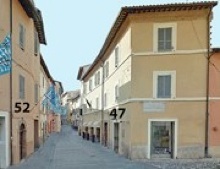
Via XX Settembre, looking towards the Duomo,
with Via Feliciano Scarpellini and the Ponte di Cesare parallel and to the right
Medieval Porta Strettura (discussed below) was between 47 and 52 Via XX Settembre
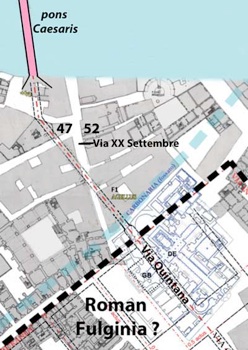
Pons Caesaris and Via della Quintana of the putative Roman city
Adapted from Camerieri and Galli (2016, p. 29, Figure 3)
My pons Caesaris = the authors’ Ponte Pietra
Ludovico Jacobilli (quoted by Paola Guerrini and Francesca Latini, referenced below, at p. 316, entry 105) recorded that a medieval gate was built:
-
“... of ancient stones, with a tower above, at the end of the street named Strettura, ... not far from the Ponte di Cesare, now called Ponte della Pietra ...” (my translation).
Fabio Pontano, in his ‘Discourse’ (1618), which has been edited by Luigi Sensi (referenced below, 2008), recorded (at p. 75) that this gate was:
-
“... near the Osteria della Campana, with this ancient tower attached” (my translation).
According to Vladimiro Cruciani (referenced below, at p. 29):
-
“Two tracts [of the 12th century walls of Foligno] survive in Via XX Settembre, at numbers 47 and 52 [marked on the photograph above]; these tracts were adjacent to Porta Strettura, which had large Roman blocks reused in its base .... [and] which was demolished in 1880 ... The gate faced the old course of the Topino, which was crossed at this point by the Ponte di Cesare” (my translation).
I wonder whether the ancient blocks used in Porta Strettura came from an Augustan arch on the putative Via Quintana, just before it crossed the pons Caesaris. If so, it would have articulated the start of a processional route from Fulginia, on the site of modern Foligno, to the pan-municipal sanctuary below Hispellum.
Fulginia in the Imperial Period
Inscriptions
A number of surviving inscriptions that relate to Fulginia attest to its vibrancy in the Imperial period. Unfortunately, they throw no light on the vexed question of the location of the municipium, since the find spots of those found in Fulginia itself are now unknown.
Forum Flaminii
The list by Pliny the Elder of the tribes of the Augustan Sixth Region’ (‘Natural History’, 3:19) following the Augustan reforms of ca. 7 BC included the ‘Fulginiates’ and the ‘Foroflaminienenses. This suggests that Fulginia and Forum Flaminii were separate municipia at that time, albeit that we have no surviving evidence for the magistracy of Forum Flaminii.

C(aio) Anchario C(ai) f(ilio) Cor(nelia)/ Vero
dec(urioni) Fulg(iniae)
aed(ili) / F(oro)f(laminiensium)
Ancharius’ assignation to the Cornelia tribe rather than the Oufentina of Forum Flaminii suggests that he came from Fulginia, which must therefore have been assigned to the Cornelia. (The altar was subsequently used to hold holy water in the church of San Giovanni Decollato, which was demolished in 1869, and is now in the Museo Archeologico. The dating above is from the museum note on the inscription).
Domitius Curvius Lucanus and Domitius Curvius Tullus (ca. 70 AD)
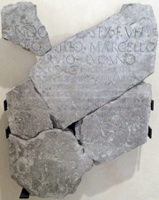
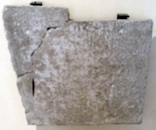
CIL XI 5210 CIL XI 5211
These two inscriptions (translated by Hugo Whitfield, referenced below, at pp. 45-6) came from the bases of statues decreed by the decurians to their city’s “best patrons”, the brothers:
-
✴Cnaeus Domitius Curvius Lucanus (CIL XI 5210); and
-
✴Cnaeus Domitius Curvius Tullus (CIL XI 5211).
Although they were the sons of Sextus Curvius, they were adopted during their father’s lifetime by the wealthy rhetorician Domitius Afer. Pliny the Younger, in his letter to Rufinus, described how Domitius Afer (who died in 59 AD) had bequeathed his considerable wealth to his adoptive sons. He also gossiped about how Domitius Tullus had adopted Domitia Lucilla, the daughter of Domitius Lucanus, in order to get his hands on his dead brother’s legacy, but had then made a handsome bequest to her on his own death in 108 AD. She had thus became extremely eligible, and ended up as the grandmother of the Emperor Marcus Aurelius. The inscriptions, which date to the reign of Vespasian (69 -79 AD), largely describe the brothers’ illustrious military careers. They were presumably found in Fuginia, and Hugo Whitfield (as above) assumed that they must have had a residence there. They are now exhibited .
Tutilia Laudica (1st century AD)
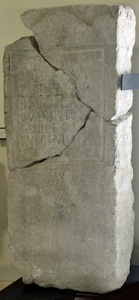
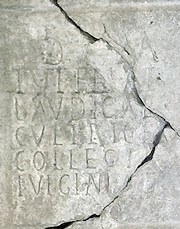
CIL XI 5223 Detail
This inscription (CIL XI 5223) in the Museo Archeologico reads:
D(is) M(anibus)/ Tutiliae/ Laudicae
cultrices/ collegi(i)/ Fulginiae
It is thus a funerary inscription, in which the ‘cultrices’(worshippers) of the college of Fulginia commemorated Tutilia Laudica, who had presumably been among their members before her death. It is not clear whether “Fulginia” referred to the Roman city or alternatively to a divinity for whom it had been named.
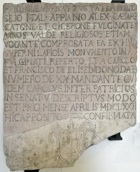
-
“... a great sensation when it was discovered because a lively debate was underway at that time on the antiquity of the city of Foligno and its Roman origins, which were denied by some scholars” (my translation).
The donors, who carefully listed the classical authors who had referred to the Roman city, now gave the world proof of its location.
The i17th century inscription records only that the Roman inscription had been found “in agro Fulginate”. However, Maria Romana Picuti (referenced below, at p. 136) reproduced information provided in 1725 by its first editor, Giustiniano Pagliarini, according to which it had been found accidentally in 1671 less than a mile from Foligno, on land owned by Marchesi Elisei. Unfortunately, the precise location of the find spot cannot be securely identified:
-
✴According to Maria Romana Picuti (referenced below, at p. 138):
-
“At the moment, it is impossible to locate topographically the land owned by the Elisei on which the inscription was found: properties of the family seem to be attested only in the areas of Pale and the Altolina, locations that cannot be described [as less than a mile from Foligno]. Nothing however prevents the hypothesis that the inscription had actually been purchased by the Elisei [brothers] ...” (my translation).
-
✴However, Fabio Bettoni and Bruno Marinelli (referenced below, at p. 62) asserted that the Elisei family owned the palace now at 14 Via XX Settembre, between Via del Oratorio and Via Elisei. This location (actually in the city) clearly does not meet Giustiniano Pagliarini’s description of the find spot, but I wonder whether he was correct?? It is interesting to note that the garden of this palace might well have included at least part of the “agellus” (cemetery) in which St Felician was thought to have been buried, and in which Tutilia Laudica could also conceivably have been interred.
Titus Haterius Nepos (2nd century AD)
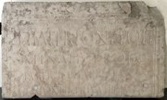
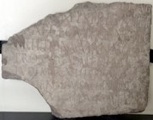

CIL XI 5212 CIL XI 5213 CIL XI 5214
Three inscriptions in the Museo Archeologico (Room 5), which presumably all came from Fulginia, commemorate Titus Haterius Nepos:
-
✴CIL XI 5213 commemorated a Prefect of Egypt. Although the first line, which would have identified him, is missing, he is usually identified as a Titus Haterius Nepos, who held the post in 120-4 AD. Catherine Ross (referenced below, at p. 136) translated the inscription as follows:
-
[To Haterius], prefect of the cohort, military tribune, prefect of the Anavionensian Britons, procurator of Augustus for Armenia Major, of the Great Training-School, and of legacies; and in charge of the census, in charge of petitions of Augustus, prefect of the Watch, prefect of Egypt, M Taminius Ce...
-
According to Antony Birley (referenced below, 1997, at pp. 100-1), who assumed that Fulginia was Haterius Nepos’ home town, this inscription also covered a hectic period of his career under the Emperor Hadrian in ca. 114-9 AD, prior to his appointment to Egypt.
-
✴CIL XI 5214 describes essentially the same career:
censi]tor[i Brittonum ...] / [ proc(uratori) ludi ma]gni her[editatium ...]
[... praef(ecto) vigil]um prae[fe(cto) Aegypti] / ... [p]atri [
-
According to Antony Birley (referenced below, 2007, at p. 307), this inscription, which seems to have been erected by a son or daughter, might well have been funerary in nature.
-
✴CIL XI 5212 reads:
T(ito) Haterio Nepoti / Atinati Probo/ Publicio Mateniano
co(n)s(uli) pontif(ici) triumphalib(us)/ [ornamentis honorato
-
This inscription commemorates the magnificently-named Titus Haterius Nepos Atinas Probus Publicius Matenianus, the suffect Consul of 134 AD. According to Antony Birley (referenced below, 2007, at p. 308), he was probably a son of the Haterius Nepos above, and his triumph probably related to his role in suppressing the second Jewish revolt (132-6 AD).
Curator Rei Publicae Fulginatium (2nd/3rd century AD)
A fragmentary inscription (CIL VI 41225) from the Via Appia in Rome commemorated a senator called something like Iasdius Domitianus, whose cursus included the post of curator Rei Publicae Fulginatium.
-
✴Jenö Fitz (referenced below, at p. 77) deduced that ‘Iasdius ?’ held the post of curator at Fulginia in ca. 193 AD.
-
✴Matelda Albanesi (referenced below, at p. 565, note 23) identified him as Lucius Iasdius Aemilianus Honoratianus, who was documented as a member of the Arval brethren in 240 AD.
Publius Aelius Marcellus (3rd century AD)
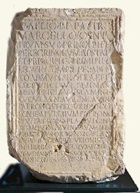

CIL XI 5215 CIL XI 5216
These inscriptions (CIL XI 5215-6) from the base of a statue found at San Giovanni Profiamma (the site of Forum Flaminii) that commemorate Publius Aelius Marcellus, a member of the Papiria tribe. Since he is also commemorated in an inscriptions from the Roman province of Apulum (in modern Romania), which belonged to this tribe, it seems certain that this had been his place of birth. He served with distinction in three legions, including the II Gemina Pia Felix, which was given this title in ca. 197 AD. It was probably thereafter that he embarked on a civic career: as decurion and patron of his native Apulum; and also as patron of the cities of Forum Flaminii, Fulginia and Iguvium (Gubbio). [What was his link to Umbria ??]
Late Imperial Period
According to Giovanni Uggeri (referenced below, at p. 105), the geographer Guidone, who included a description of the road network of Italy as it had been in the middle of the 4th century in his ‘Geographica’ (1119), placed Foligno at the intersection of three of the routes that he described, placed Foligno at the intersection of three of the major roads:
-
✴on the eastern branch of Via Flaminia, between Nocera and Spoleto;
-
✴and on two transversal routes from Foligno:
-
•towards the west, via Spello, Assisi and Perugia to Cortona; and
-
•towards the east, via Plestia to Ancona.
One wonders whether this strategic location contributed to what seems to have been the subsequent abandonment of the city (as discussed on the following page) one the security of the Roman heyday became a memory.
![Read more:
E. Zuddas, “Dal Quattuorvirato al Duovirato: gli Esiti del Bellum Perusinum e i Cambiamenti Costituzionali in Area Umbra”, in
S. Evangelisti and C. Ricci (Eds), “Le Forme Municipali in Italia e nelle Province Occidentali tra o Secoli I AC e III DC: Atti della XXIe Rencontre Franco-Italienne sur l’ Épigraphie du Monde Romain (Campobasso, 24-26 settembre 2015)”, (2017) Bari, at pp. 121-32
P. Camerieri, Giovanna and Giuliana Galli (Eds.), “Dal Castrum alla via Quintana, dal Tempio alla Cattedrale: Studi Topografici e Architettonici tra Ambiguità Storiche e Anomalie Urbanistiche”, (2016) Foligno:
P. Camerieri and Giuliana Galli, “Dal Castrum Romano alla Cattedrale: Rilettura della Passio Sancti Feliciani nel Contesto Topograico Castramentato di Foligno”, pp. 15-31
P. Camerieri, “Una Rilettura Topografica e Architettonica delle Vicende del Martire Feliciano e degli Edifici di Culto da Lui e a Lui Dedicati”, pp. 33-57
Giuliana Galli, “Ab Origine: Ipotesi sul Riconoscimento delle Persistenze Topografiche
e Architettoniche di un Tempio Pagano nel Sito della Cattedrale: la Fase d’ Età Romana (III sec. a.C.-III sec. d.C.)”, pp. 89-107
Giuliana Galli, “Valutazione Consuntive con Aggionamento dei Dati Topografico-Archeologici e Prospettive di Ricerca”, pp. 108-23
N. Lenski, “Constantine and the Cities: Imperial Authority and Civic Politics”, (2016) Philadelphia
G. Galli (Ed.), “Foligno, Città Romana: Ricerche Storico, Urbanistico e Topografiche sull' Antica Città di Fulginia”, (2015) Foligno, includes:
G. Galli, “Foligno Città Romana: Considerazioni sugli Studi Topografici e sulle Emergenze Archeologiche”, pp. 35-74
P. Camerieri, “Il Castrum e la Pertica di Fulginia in Destra Tinia”, pp. 75-108
I. Pinder, “Augustan City Walls in Roman Italy: their Character and Meanings”, (2015), doctoral thesis from the University of Southampton
C. H. Lange, “The Triumph outside the City: Voices of Protest in the Middle Republic”, in:
C. H. Lange and F. J. Vervaet (Eds), “The Roman Republican Triumph: Beyond the Spectacle”, (2014) Rome, pp. 67-81
M. Albanesi, “Indagini a Santa Maria in Campis di Foligno: una Fase Tardoantica a Fulginia”, Bollettino Storico della Città di Foligno, 37 (2014) 559-66
M. Romana Picuti, “Tra Epigrafia e Antiquaria: le Iscrizioni di Supunna e delle Cultrices Collegi Fulginiae nel De Diis topicis Fulginatium di Giacomo Biancani Tazzi”, in:
E. Laureti (Ed.), “G. Biancani: De Diis Topicis Fulginatium Epistola, Foligno 1761”, (2014 ) Spello, pp. 129-43
P. Guerrini and F. Latini, “Foligno: Dal Municipium Romano alla Civitas Medievale: Archeologia e Storia di una Città Umbra”, (2012) Spoleto
S. Ranucci [a], “Tesoretto Rinvenuto nel 1962”; and
S. Ranucci [b], “Il Ripostiglio Monetale da Piazza Risorgimento”; both in
M. L. Manca and S. Ranucci (Eds.), “I Tessoretti Romani di Foligno”, (2012) Perugia, at pp. 11-16 and pp. 23-6 respectively
S. Ranucci [c], “Il Ripostiglio di Denari Romani Repubblicani da Piazza Risorgimento a Foligno: Reliqua Pars”, Annali dell’Istituto Italiano di Numismatica, 58 (2012) 79-137
S. Sisani, “I Rapporti tra Mevania e Hispellum nel Quadro del Paesaggio Sacro della Valle Umbra”,, in
G. Della Fina (Ed.), “Il Fanum Voltumnae e i Santuari Comunitari dell’ Italia Antica”, (2012) Orvieto (pp. 409-64)
H. Whitfield, “The Rise of Nemausus from Augustus to Antoninus Pius: A Prosopographical Study of Nemausian Senators and Equestrians”, (2012) Thesis, Queen’s University, Kingston, Ontario, Canada
E. Zuddas and M. Spadoni, “La Lemonia nella Valle Umbra”, in
M. Silvestrini (Ed.), “Le Tribù Romane: Atti della XVIe Rencontre sur l’ Épigraphie (Bari 8-10 ottobre 2009”, (2010) Bari
C. Ross, “'Tribal Territories' from the Humber to the Tyne: an Analysis of Artefactual and Settlement Patterning in the Late Iron Age and Early Roman Periods”, (2009), thesis from the University of Durham
L. Sensi (Ed.), “Discorso di Fabio Pontano sopra l’ Antichità della Città di Foligno”, (2008) Foligno
P. Camerieri, “Il Catasto Antico di Mevania: Primi Studi sull' Assetto Territoriale della Città Romana”, in:
M. Trabalza and R. Colacicchi, “Invito al Parco: Lungo i Percorsi delle sue Aque e della sua Storia”, (2007) Foligno, 147–58
S. Sisani, “Fenomenologia della Conquista: La Romanizzazione dell' Umbria tra il IV sec. a. C. e la Guerra Sociale”, (2007) Rome
J. Osgood, “Caesar’s Legacy”, (2006) Cambridge
P. Braconi, “Les Premiers Propriétaires de la Villa de Pline le Jeune in Tuscis”, Histoire et Sociétés Rurales, 19.1 (2003) 37-50
L. Baiolini, “ La Forma Urbana dell' Antica Spello”, in:
L. Quilici and S. Quilici Gigli (Eds), “Città dell' Umbria”, (2002) Rome, pp. 61-120
F. Bettoni and B. Marinelli, “Foligno, Itinerari Fuori e Dentro le Mura”, (2001), Foligno
G. Uggeri, “L' Organizzazione della Viabilità in Umbria nella Tarda Antichità”, in
“Umbria Cristiana: Dalla Diffusione del Culto al Culto dei Santi”, Spoleto (2001)
G. Bradley, "Ancient Umbria", (2000) Oxford
V. Cruciani, “Mura e Città: Il Caso di Foligno nel Trecento”, (1998) Foligno
A. Birley, “Hadrian: The Restless Emperor”, (1997) Abingdon
J. Carter, “Appian : The Civil Wars”, (1996) London
D. Manconi, P. Camerieri and V. Cruciani, “Hispellum: Pianificazione Urbana e Territoriale”, in:
G. Bonamente and F. Coarelli (Eds),“Assisi e gli Umbri nell' Antichità” Assisi (1996) pp. 375-423; the section on the sanctuary is at pp. 381-92
J. Crawford, “M. Tullius Cicero: The Fragmentary Speeches. An Edition with Commentary”, (1994) Atlanta
S. Demougin, “Prosopographie des Chevaliers Romains Julio-Claudiens ”, (1992) Rome
F. Hickson, “Augustus ‘Triumphator’ : Manipulation of the Triumphal Theme in the Political Program of Augustus”, Latomus, 50:1 (1991) 124-38
P. Fontaine, “Cités et Enceintes de l'Ombrie Antique” (1990) Brussels
L. Sensi, “Fulginia: Appunti di Topografia Storica”, Bollettino Storico della Città di Foligno, 8 (1984) 463-92
L. Keppie, “Colonisation and Veteran Settlement in Italy, 47–14 BC”, (1983) Rome
J. Fitz, “La Carrière de [Iasius ?]”, Revue Belge de Philologie et d' Histoire”, 65:1 (1978) 71-9
G. Dominici, “Fulginia: Questioni sulle Antichità di Foligno”, (1935) Verona
L. Ross Taylor, “The Latina Colonia of Livy xl. 43”, Classical Philology, 16:1 (1921) 27-33
History of Fulginia: From Conquest to Municipalisation After Municipalisation
Location of Roman Fulginia Roman Walk I Roman Walk II Roman Walk III
Forum Flaminii Plestia
Return to History of Foligno](Fulginia__after_Municipalisation_files/shapeimage_2.png)






































